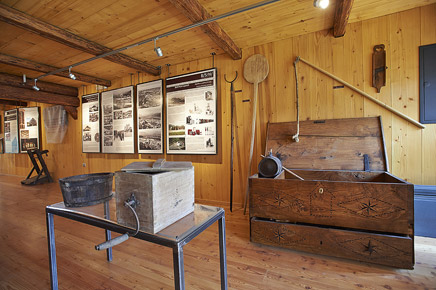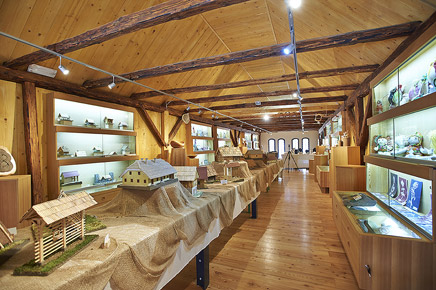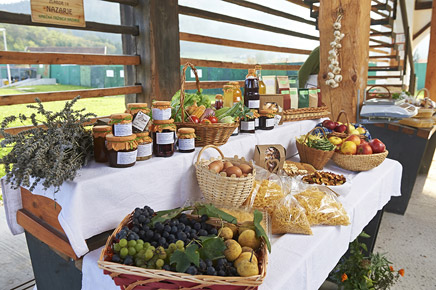- MUSEUM
-
EDUCATIONAL TRAIL
-
Natural and cultural educational trail Monastery Hill
- Everything is connected to everything
- What is a forest? What does the forest mean to me?
- It is home to mixed deciduous forests.
- Forests protect and preserve!
- The Upper Savinja Valley (Zgornja Savinjska dolina) is covered by vast and varied forests.
- They looked after people's spiritual and physical health and knowledge.
- The forest is a treasure trove of biodiversity, and it is full of life.
- The circulation of substances in nature allows new growth
- Natural regeneration of forests
- How old am I? Count it!
- Rock and soil
- Acacia overgrowth
- Spruce is an increasingly threatened tree species in the lowlands
- What does a forester do?
- Wetland is not a dump!
- The forest edge protects, conserves and enriches the forest
- Water and the forest are linked and interdependent
- Confluence of Savinja and Dreta
- Treating the forest with care when we visit it
-
Natural and cultural educational trail Monastery Hill
- BOHAČ DOUBLE HAYRACK
- SCHOOL PROGRAMMES
- PROGRAMMES FOR ADULTS
- FAMILIES
- ABOUT MUSEUM
- CONTACT
- OPENING HOURS AND PRICES
BOHAČ DOUBLE HAYRACK
In the centre of Nazarje, in the courtyard behind the once great Bohač Inn, there stands a large double hayrack – the Bohač double hayrack. Sometime after 1874 it was erected by its owner at the time, a merchant and innkeeper Anton Turnšek, whose domestic name was Bohač. It was built by bricklayers from Friuli, who were in charge of building works in Styria from the mid 19th century primarily on rich farms.
Hayrack belongs among the most important economic buildings on the Slovenian territory. Its design and image represent an architecturally unique building both in the Upper Savinja Valley as well as in the wider region. Both frontal walls are fully made of bricks, covered with lime and decorated with masonry ventilation holes in three levels. The four intermediate support pillars and support brackets are made of oak.
After losing its function, the hayrack started to decay, became an old junk heap, until it was purchased by the Nazarje Municipality, who fully renovated it and gave it completely new contents. Today, the Bohač double hayrack represents an important cultural monument of the place and the entire Upper Savinja Valley.
The Nazarje Through Time Exhibition
The first floor of the mighty double hayrack houses an exhibition which takes us through the historical development of places in the Nazarje Municipality and their changing image.
We get to know how Nazarje developed after the Second World War from a small hamlet at the confluence of the Savinja and Dreta Rivers, which is today an employment centre of the Upper Savinja Valley. The main sights in Nazarje are presented: Vrbovec Castle and the Franciscan monastery with the Church of Mary of Nazareth. The exhibition also shows the history of the wood industry, as the expansion of industrial facilities contributed to the development of the place, and the development of a plant B/S/H Hišni aparati Nazarje.
The inhabitants of the surrounding places were mainly occupied with agriculture, rafting and sawmilling, but also with pottery. This is why the exhibition awakens the memories of pottery in the Dreta Valley, which originated from the 14th century and was famous for its containers black as graphite. The exhibition also partly represents the image of daily life and especially of the peasants.
Handicraft and Arts Exhibition and Sales Gallery
The sales and exhibition space in the attic of the Bohač double hayrack combines creators of handicraft and arts products from the Upper Savinja Valley. Unique, handmade products are mainly presented, which show the effort, lifestyle and environment of the producer:
- Products made of clay (small vases, bowls, decorative objects, sculptures, etc.)
- Products made of wood (bowls, sculptures, pictures, mind games, useful objects, etc.)
- Products made of glass – stained glass (bowls, candlesticks, vases, glass jewellery, etc.)
- Products made of fleece and wool (socks, slippers, hats, soaps, jewellery, etc.)
- Products made of polymers (jewellery, 3D pictures)
- Products woven on a loom and painted (bags, scarves, etc.)
- Handmade cards for any occasion and unique candles
- Old Christian rope symbols
Also on display are bobbin-lace products and various embroidery products, and particularly interesting is the replica exhibition of old houses, mills, granaries, hayracks, sawmills, charcoal piles, etc., which takes us back in time to the of lives of our ancestors.
Farmers Market
Every Saturday morning, a farmers market awakens in the ground floor of the Bohač double hayrack. It brings together providers from the entire Upper Savinja Valley, who offer various home-made delicacies:
- Bread from a brick oven
- Slovenian rolled cakes “potica”, pastries, noodles
- Dairy products
- Dried-meat products
- Bee products
- Teas, herbs, spices
- Vinegar, cider, wine, spirits
- Jams, juices, syrups
- Dried fruits, forest fruits
The market also offers tastings and lunch for organised groups, and there are also different events hosted there: singing, dance and musical appearances, creative workshops, presentations, etc. As a result, the market and the whole hayrack are not merely a space for selling, but are becoming increasingly popular as a space for socialising.




